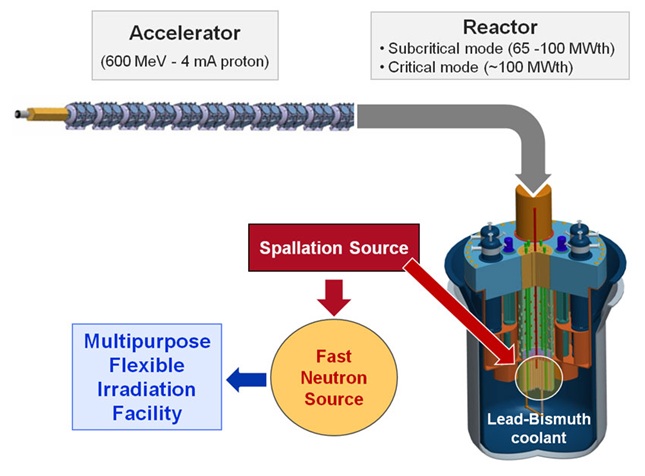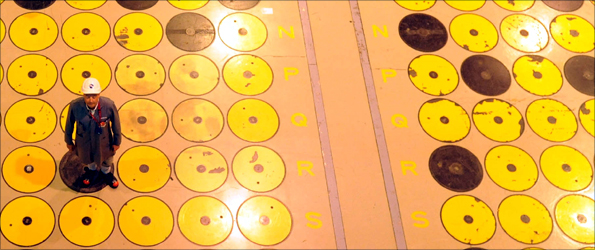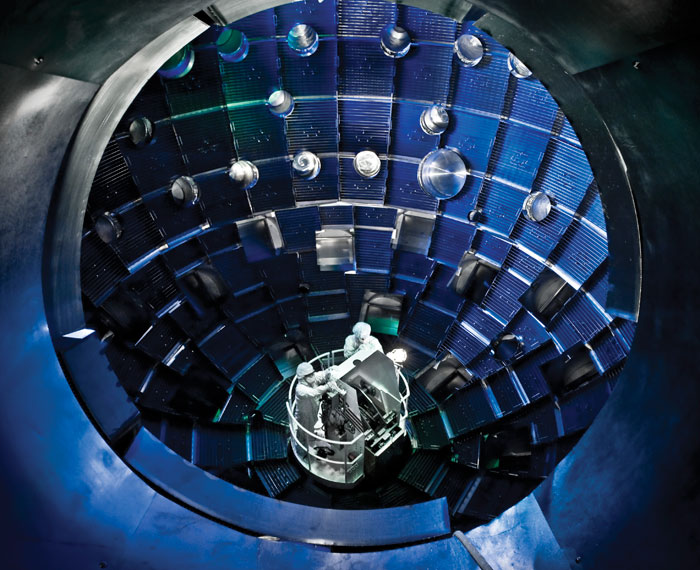Prospects
Prospects
Despite already playing an important role in our lives, the influence of particle accelerators is set to increase further in the future. New applications of particle accelerators in important areas like Health and Energy are hot prospects for the future.
Cleaner and Safer Nuclear Power
Similarly to hydro energy and wind power, nuclear power generates very small amounts of greenhouse gases. By the year 2030 world-wide the amount of electricity generated from nuclear power is forecasted to increase by 2-3 times. However, public opinion in many, particularly European, countries is negative regarding nuclear power and is strongly dominated by two major concerns. The first is the risk of nuclear accidents, like Chernobyl or Fukushima, and the second is the long-lived radiotoxic waste, resulting from spent fuel elements. Since the early nineties, techniques using accelerators have been proposed to allay these concerns.
How nuclear reactors work
In the process of nuclear fission in a conventional nuclear reactor, a neutron is absorbed by a Uranium 235 (235U) nucleus. As this excited nucleus fissions, typically between 2 to 3 neutrons are emitted. Some of these emitted neutrons are lost (for example in absorption into 238U, which gives rise to the generation of Plutonium and subsequently to other minor Actinides) while others in turn produce a fission of another 235U.
A nuclear reactor operates at what is called equilibrium. This is where each fission gives rise to exactly one further fission. A situation where multiple fissions result from single fissions would cause an explosive chain reaction if not stopped. Whereas a lack of enough fissioning neutrons would lead to what is known as an extinction. In this last case, a reactor is said to be subcritical. In practice, a conventional critical reactor relies on delayed neutrons (i.e. neutrons emitted after a fission event by one of its fragments) for keeping the chain reaction at equilibrium.
Accelerator Driven Systems (ADS)
As the name suggests, an Accelerator-Driven Subcritical Reactor (ADSR) relies on neutrons produced by an accelerator driving the reaction. Protons from an accelerator hit a neutron producing spallation target located within a subcritical nuclear reactor. The rate of neutrons produced totally depends on the easy-to-control accelerator beam and can therefor sustain the fission process.
|
MYRRHA (Multi-purpose hybrid research reactor for high-tech applications) is conceived as an accelerator driven system (ADS) able to operate in sub-critical and critical modes. It contains a proton accelerator of 600 MeV, a spallation target and a multiplying core with MOX fuel, cooled by liquid lead-bismuth (Pb-Bi). Image credit: SCK-CEN Belgian Nuclear Research Centre in Mol. |
The spallation neutrons extend over a large energy range. Therefore, such subcritical system can use fuel with degraded neutronic properties. For example, minor actinides that constitute the long-lived radioactive waste emit a negligible number of delayed neutrons and therefore only a very small amount can be transmuted in critical systems. On the other hand, an ADSR can use fuel that may contain up to 50% waste, and transform it to shorter lived and less radiotoxic fission products.
|
A solution for nuclear waste?: Above, BBC reporter Chris Jackson is underground at the Sellafield nuclear waste storage facility, England, where nuclear waste is stored encased in concrete. Image copyright & courtesy of BBC Inside Out [The use of this image in no way implies that the BBC shares the views of the authors of this website or those of the TIARA on the benefits of particle accelerators, the processing of nuclear waste or of any of the other topics covered in this website.] |
Intrinsically, the ADSR, with its subcritical fuel assembly, has increased safety as it is protected against a number of types of critical accidents. However, the same amount of heat is produced by radioactive decay whether traditional methods are used or ADSR is used, meaning that the same safety risks are present in the event of a cooling failure after stopping the reactor.
ADSR may also be very advantageously used with Thorium fuel. Indeed, Thorium itself is not fissile, it is however "fertile", meaning that using a neutron source fissile material can be produced. This alternate fuel cycle produces almost no minor actinide waste. It would also be very difficult to produce nuclear weapons from it. A final important asset is the abundance of Thorium, 3 times more so on Earth than Uranium and often occurring in a rather concentrated way. Currently, India, for example, is actively researching accelerator driven systems (ADSs) as, due to its very large Thorium reserves, it is one of the countries with much to gain from the development of ADSs.
For more information on ADSs see;
Web (MYRRAH): MYRRAH: Multi-purpose hYbrid Research ReActor for High-tech applications
See also applications catalogue of MYRRHA.
Article [2012] (CNRS): GUINEVERE: Towards Cleaner Nuclear Energy
Article [2009] (Guardian): What do you get when you cross an accelerator with a nuclear reactor?
Lecture [2011]: Accelerator-Driven Subcritical Reactors or How Accelerators Can Save the Planet
Article [2011] (World Nuclear Association): Accelerator Driven Nuclear Energy
(+) Doc (CEA) [French]: Des réacteurs sous-critiques pilotés par accélérateur dédiés à la transmutation des déchets?
![]() Video: ADSR Energy from Thorium
Video: ADSR Energy from Thorium
8min56s
For more information on Accelerator Transmutation of Waste see;
Web [2011] (Stanford University): Accelerator Transmutation of Waste
Article [2012] (Symmetry Magazine): Taking the Heat out of Nuclear Waste
Fusion Power
Unlike in the nuclear fission reactors of current nuclear power stations where atoms are ‘split’ to produce energy, proposed nuclear fusion reactors would fuse together atoms to produce energy, the same way that the sun generates its energy.
|
Fusion energy: Accelerator technologies may bring the power of the sun “down to earth”. Image credit: CEA/IRFU For more information on fusion energy in general see; Web (ITER): What is Fusion? |
There are two approaches to the fusion reactor that currently dominate nuclear fusion research. They differ in the method of confinement of the plasma (a state of matter similar to a gas in which atoms are heated such that they become charged ionized particles, the environment required for fusion to be possible), Magnetic Confinement and Inertial Confinement. In both approaches particle accelerators play an important role.
Magnetic confinement fusion
In the magnetic confinement approach to nuclear fusion, the plasma is confined by a large magnetic field. In order for fusion to be possible, this plasma needs to be heated to an extremely high temperature (150,000,000oC). Reaching this almost unfathomably high temperature is not possible by any one heating method alone. Researchers at the International Thermonuclear Experimental Reactor (ITER), based in Cadarache in the south of France use three heating techniques in order to heat the plasma to the required temperature, Ohmic heating, neutral beam injection and high-frequency waves.
Neutral beam injection is the process of firing high energy particles into the plasma. This is done by accelerating charged Deuterium (an isotope of Hydrogen with a nucleus made up of one proton and one neutron) particles using a particle accelerator. The particles then pass through an ‘ion beam neutralizer’ which removes the particle’s charge. These high energy neutral particles are then injected into the plasma where they transfer energy to the plasma particles through collisions.
For more information see;
Web (EFDA, European Fusion Development Agreement): Neutral Beam Injection
Web (ITER): Reaching 150,000,000oC
![]() Video: ITER Fusion Reactor
Video: ITER Fusion Reactor
1min53s
Inertial confinement fusion
In the inertial confinement approach to nuclear fusion, a small pellet of fuel is compressed and heated. If the pellet is compressed quickly enough, the temperature and density of the pellet will increase to the point where the nuclei in the pellet will collide and fuse. The pellet is compressed and heated using what is known as an ‘energy driver’. One energy driver used is an ion beam fired from a particle accelerator.
|
Energy Driver: A small pellet of fuel is put under immense pressure and heated in an experimental nuclear reactor in the hope of replicating the reactions that power the stars. Image credit: Lawrence Livermore National Laboratory |
For more information see;
Web (National Ignition Facility, LBNL): Internal Confinement Fusion: How to Make a Star
Web (Think Quest): Inertial Confinement Fusion
Web (Hyperphysics): Inertial Confinement Fusion
Replacing Ageing Research Reactors
Most of the radioisotopes such as Technetium-99m (Tc-99m) used for medical imaging applications are currently produced using research reactors. An alternative and more advantageous manufacturing techniques, using different types of accelerators such as cyclotrons or linacs (see section types of accelerators) are being studied.
For more information see;
Doc [2010] (weblogs.vpro.nl): Medical Radioisotopes Production Without A Nuclear Reactor
Article [2011] (medicalphysicsweb): Cyclotron production of Tc-99m is viable. Paper in Phys. Med. Biol. 56 (2011) 5469–5484 available at iopscience.iop.org.
Article (nrc-cnrc.gc.ca): Solving Canada’s Medical Isotope Crisis
For a more general view:
![]() Video (TRIUMF Canada): The Future of Nuclear Medicine
Video (TRIUMF Canada): The Future of Nuclear Medicine
3min04s




